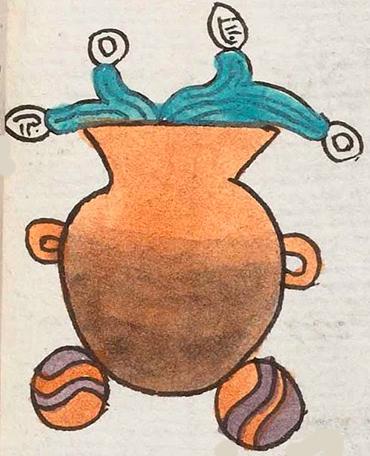atotonilli (Mdz30r)
This simplex glyph duplicates the place name, Atotonilco, adding visual vocabulary to the collection, doubling here as the glyph for atotonilli (hot water). To express the concept of hot water, the glyph includes a ceramic pot (terracotta-colored) with a black bottom. It sits on two stones (with the typical wavy lines of purple and orange or terracotta coloring), and water spills over the edges of the top of the pot. The water is a turquoise blue. The -co locative suffix, intentionally or not, can be conveyed by the ceramic pot (comitl).
Stephanie Wood
This simplex glyph could be considered a compound, given that it contains elements that are also glyphic in and of themselves--the stones (tetl), the water (atl), and the pot (comitl), with all their classic glyph-like characteristics (droplets and shells on the water and wavy lines on the stones). Atotonilco is likely a place with hot springs or thermal waters, having nothing to do with cooking, even if that visual is meant to bring forth the phonetic reading of hot water.
Stephanie Wood
Stephanie Wood
c. 1541, but by 1553 at the latest
Stephanie Wood
water, shells

atotonil(li), hot water, https://nahuatl.wired-humanities.org/content/atotonilli
totonil(ia), to heat something, https://nahuatl.wired-humanities.org/content/totonilia
a(tl), water, https://nahuatl.wired-humanities.org/content/atl
hot water
Stephanie Wood
Codex Mendoza, folio 30 recto, https://digital.bodleian.ox.ac.uk/objects/2fea788e-2aa2-4f08-b6d9-648c00..., image 70 of 188.
The Bodleian Libraries, University of Oxford, hold the original manuscript, the MS. Arch. Selden. A. 1. This image is published here under the UK Creative Commons, “Attribution-NonCommercial-ShareAlike 3.0 License” (CC-BY-NC-SA 3.0).
